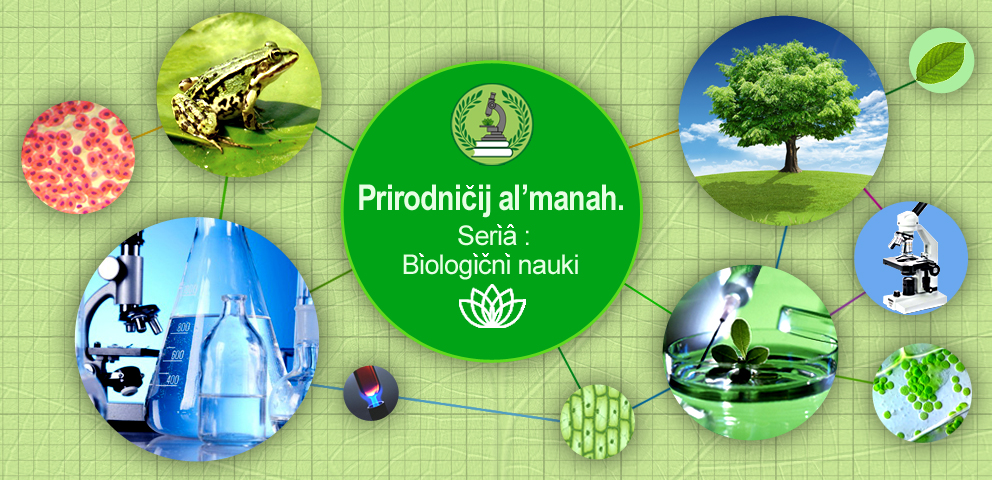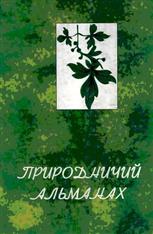CHANGE IN MARKER INDICATORS (ACTIVITY OF ALKALINE PHOSPHATASE AND MALONDIALDEHYDE CONTENT) IN RUDD SCARDINIUS ERYTHROPHTALMUS (L.), AS INDICATORS OF WATER POLLUTION
M. V. Prychepa, Yu. O. Kovalenko
Abstract
The article discusses the changes in individual biochemical indicators of the Rudd under the anthropogenic pressure. The Rudd, which was caught in the summer from water bodies with different anthropogenic loads, was the object for research. A high content of malondialdehyde (by 31.4%) was found in fish from a polluted water body (Lake Kirillovske) compared with fish from a conditional control (Lake Babyne). An increase in the content of malonic dialdehyde
indicates a violation of the rate of processes of plastic and energy metabolism in the liver tissues. The change in this indicator confirms the presence of unfavorable living conditions for Rudd during research. A confirmation of the chronic stress, experienced by the studied individuals of the Rudd, is a change in the activity of alkaline phosphatase. In muscle tissues, the activity of this enzyme was by 36.11% higher than in the control group. This indicates the activation of phosphorus metabolism in these tissues of the Rudd. In contrast, a lower activity of alkaline phosphatase was found in the tissues of the liver and gills, which is a consequence of the specific environmental conditions of existence. The differences between the studied groups of fish, in terms of biochemical markers, proves that they are under significantly different ecological and toxicological conditions. The study of the physiological state of Rudd on the impact of anthropogenic pollution should be considered through a number of physiological and biochemical parameters that can fully provide the information on the physiological state of natural groups of this species. This is necessary to establish, in the future, changes that can occur within different fish populations.
Changes in the physiological state of Rudd (for example, the activity of alkaline phosphatase and the content of malondialdehyde) as additional evaluation criteria can be used to predict the ecological state of water bodies experiencing anthropogenic pollution.
References
2.Жежеря ВА, Линник ПМ, Зубенко ІБ. Уміст та форми знаходження металів у озерах системи Опечень (м. Київ). Наукові праці УкрНДГМІ. 2016; 269:70–86.
3.Израэль ЮА. Проблемы антропогенной экологии // Научные аспекты экологических проблем России. Москва. Наука, 2009. Т. 1. 221 c.
4.Конвенція про біологічне різноманіття п’ятий національний звіт України. Міністерство екології та природних ресурсів України, Київ. 2015. 68 с.
4.Коваленко ЮО. Зміна вмісту малонового діальдегіду та активності лужної фосфатази у тканинах карася сріблястого (Сarassius auratus (Bloch, 1782)) за дії токсичного забруднення водойми. Тези доповідей. Конференція молодих дослідників-зоологів – 2019. (Київ, 13-14 листопада 2019), Зоологічний кур’єр №13, м. Київ, Інститут зоології НАН України, с. 13.
5.Коваленко ЮО. Фізіолого-біохімічні особливості адаптації карася сріблястого до забруднення водойм амонійним азотом. Гідроб журнал. 2019; 55 (1): 65–73.
6.Лакин Г. Ф. Биометрия. Москва. Наука. 1990. 296 с.
7.Методи гідроекологічних досліджень поверхневих вод. Ред. Романенко ВД. Київ: ЛОГОС. 2006. 408 с.
8.Олексюк НП, Янович ВГ. Вплив сезону на перекисне окиснення ліпідів у тканинах ставкових риб. Біологія тварин. 2003: 5 (1) – 2:180–183.
9.Особа ІА. Біологічна роль перекисного окиснення ліпідів у забезпеченні функціонування організму риб. Рибогосподарська наука України. 2013; 1: 88–96.
10.Панасюк ІВ, Томільцева АІ, Зуб ВВ. та ін. Якість води у міських водоймах та характер освоєння водоохоронних зон (на прикладі озер системи «Опечень», м. Київ). Екологічна безпека та природокористування. 2015; 4 (20):63–69.
11.Панасюк ІВ,Томільцева АІ, Скідан ВВ. та ін. Упорядкування водоохоронних зон міських водойм на основі екологічної оцінки якості вод. Ред. Панасюк ІВ. Київ. 2016. 94 с.
12.Причепа МВ. Вплив антропогенного забруднення водойм на морфо-фізіологічні та біохімічні показники окуня (Рerca fluviatilis Linnaeus, 1758) в різні сезони року. Рибогосподарська наука України. 2020; 2(48):52–66.
13.Романенко ОВ, Арсан ОМ, Кіпніс ЛС. та ін. Екологічні проблеми київських водойм і прилеглих територій. Київ: Наукова думка. 2015. 189 с.
14. Стальная ИД. Метод определения диеновой коньюгации ненасыщенных жирных кислот . Москва. Медицина. 1997. 68 c.
15. Худіяш ЮМ, Причепа МВ, Потрохов ОС. та ін. Вплив екологічних умов окремих озер м. Києва на стан іхтіофауни. Рибогосподарська наука України. 2020; 1(54):28-43.
16.Anderson T, Forlin L, Hardig J, Larson AC. A physiological disturbances in fish living in coastal water polluted with bleached Kraft pulp mill effluents. J. Fish Aquat Sci. 2002; 45: 1525–1536.
17. de La Torre FR. Ferrari L, Salibian A. Biomarkers of a native fish species (Cnesterodon decemmaculatus) application to the water toxicity assessment of a peri-urban polluted river of Argentina. Chemosphere. 2005;59(4): 577– 583. DOI: 10.1016/j.chemosphere.2004.12.039
18. Guinan ME, Kapuscinski KL, Teece MA. Seasonal diet shifts and trophic position of an invasive cyprinid, the rudd Scardinius erythrophthalmus (Linnaeus, 1758), in the upper Niagara River. Aquatic Invasions. 2015; 10 (2):217–225. DOI:http://dx.doi.org/10.3391/ai.2015.10.2.10
19. Molina R, Moreno І, Pichardo S, Jos A, Moyamo R, Monterde JG, Camean A. Acid and alkaline phosphatase activities and pathological changes induced in Tilapia fish (Oreochromis sp.) exposed subchronically to microcystins from toxic cyanobacterial blooms under laboratory conditions. Toxicon. 2005; 46(7):725–735.
20. Nurminen L, Horppila J, Lappalainen T. Malinen. Implications of rudd (Scardinius erythrophthalmus) herbivory on submerged macrophytes in a shallow eutrophic lake. Hydrobiologia. 2003; 506-509:511–518.
21.Varadarajan R. Biochemical effects of different phenolic compounds on Оreochromis mosambicus (Peters). Doctor of philosophy in biochemistry: Cochin-682016. India, 2010. 250 p.
22.Viarengo A, Lowe В, Bolognesi С, Fabbi E, Koehler A. The use of biomarkers in biomonitoring: A 2-tier approach assessing the level of pollutant-induced stress syndrome in sentinel organisms. Comp. Biochem. Physiol. 2007; 146 C: 281–300. DOI: 10.1016/j.cbpc.2007.04.011

